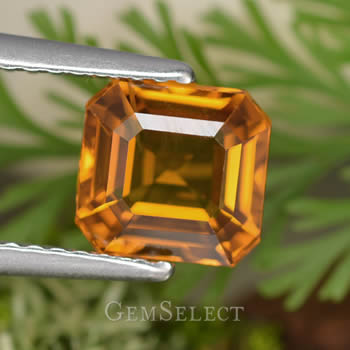Thai Beryllium Scandal
Beryllium treatment of certain colors of sapphire has become an accepted practice in the gemstone trade, provided that the treatment is properly disclosed. However, 6 or 7 years ago the introduction of loose sapphire treated with beryllium created an enormous scandal that severely disrupted both the Thai sapphire business and the whole sapphire market. There are lessons we can all learn from this ugly affair.

Beryllium-Treated Orange Sapphire
In 2001, large quantities of padparadscha-colored sapphires began to appear in the market in Thailand. These were a pinkish-orange color that is very rare in nature and is coveted by collectors. Padparadscha is particularly popular in the Japanese market. Not surprisingly, Japanese wholesalers rushed to buy large quantities of these new sapphires, which were sold simply as "heated", a treatment that is generally accepted in the trade.
Gemologists were suspicious of these alleged padparadscha sapphires, but it took until 2002 before the Gemological Institute of America (GIA) and the American Gem Trade Association's (AGTA) gem labs were able to determine the presence of large concentrations of beryllium in these sapphires. It appeared that beryllium had been diffused into the stones during the heating process. However, unlike earlier diffusion treatments that colored only the surface of the stone, this beryllium treatment penetrated the gem more deeply.
Beryllium is a well known element in the gem world, since it is an essential constituent in many gemstones, including emerald, beryl, aquamarine and chrysoberyl. When sapphires are heated with beryllium, the result is a reduction in blue tones. Thus bright yellow or orange sapphire can be produced from weak yellow or greenish gems, and beautiful blue sapphire can be produced from overly dark stones. This discovery was made by inventive gem treaters in Chanthaburi, Thailand.

When it was revealed that these new sapphires had been treated with beryllium, many buyers understandably felt cheated. Exports of sapphires to Japan came to an abrupt halt, and in fact the entire sapphire market in Japan collapsed due to lack of trust. Sapphire sales in Europe and America also saw a serious decline.
In February 2003, the Chanthaburi Gem and Jewelry Association formally agreed to fully disclose all beryllium treatments of sapphire, and vowed to expel any member who failed to adhere to the new disclosure system. This move was the result of pressure from the international market. However, the Thai sellers were also badly affected by the scandal. Though some opportunists made some large short-term profits from selling beryllium-treated sapphires without disclosure, the end result was that the Thai gem industry suffered much greater long-term losses.
Six years after the scandal, beryllium-treated sapphires are widely traded with full disclosure. Buyers looking for vivid orange and yellow sapphires are happy with these treated sapphires, since the color change is stable and permanent. At first the beryllium-treated material traded at a significant discount compared to stones that had been exposed to simple heat treatment. By 2008 the price gap had narrowed significantly.
|
